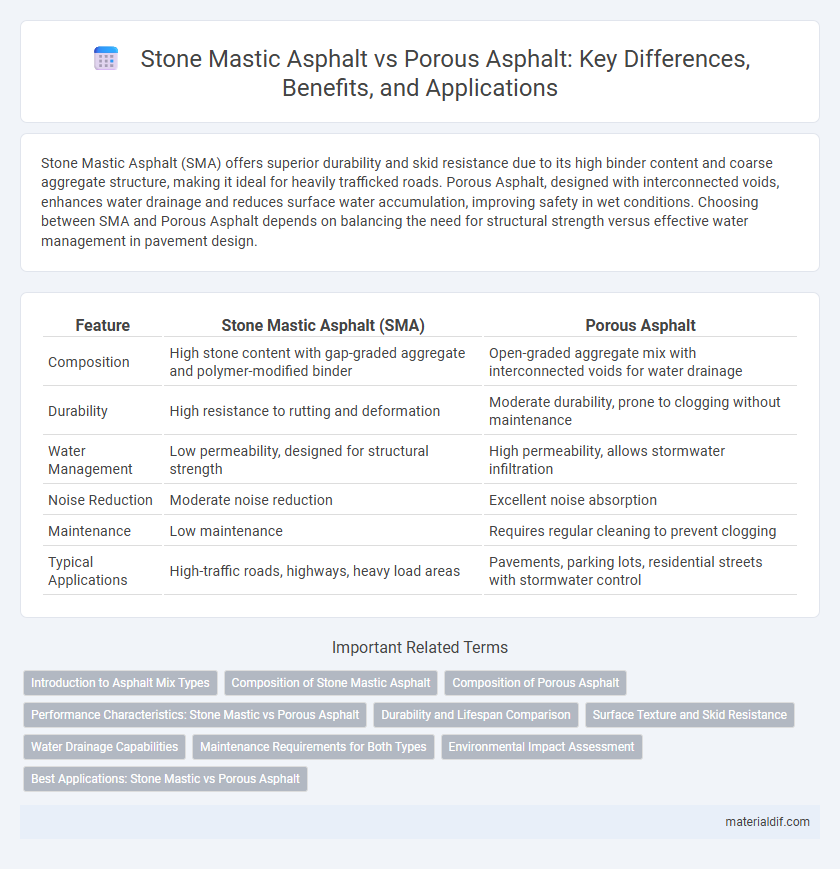Stone Mastic Asphalt (SMA) offers superior durability and skid resistance due to its high binder content and coarse aggregate structure, making it ideal for heavily trafficked roads. Porous Asphalt, designed with interconnected voids, enhances water drainage and reduces surface water accumulation, improving safety in wet conditions. Choosing between SMA and Porous Asphalt depends on balancing the need for structural strength versus effective water management in pavement design.
Table of Comparison
| Feature | Stone Mastic Asphalt (SMA) | Porous Asphalt |
|---|---|---|
| Composition | High stone content with gap-graded aggregate and polymer-modified binder | Open-graded aggregate mix with interconnected voids for water drainage |
| Durability | High resistance to rutting and deformation | Moderate durability, prone to clogging without maintenance |
| Water Management | Low permeability, designed for structural strength | High permeability, allows stormwater infiltration |
| Noise Reduction | Moderate noise reduction | Excellent noise absorption |
| Maintenance | Low maintenance | Requires regular cleaning to prevent clogging |
| Typical Applications | High-traffic roads, highways, heavy load areas | Pavements, parking lots, residential streets with stormwater control |
Introduction to Asphalt Mix Types
Stone Mastic Asphalt (SMA) features a coarse aggregate skeleton with high stone content, providing superior rut resistance and durability for high-traffic roads. Porous Asphalt incorporates a void structure designed for effective water drainage, reducing surface water and enhancing skid resistance in wet conditions. Both asphalt mix types serve distinct functional purposes, with SMA excelling in strength and longevity, while Porous Asphalt optimizes stormwater management and pavement safety.
Composition of Stone Mastic Asphalt
Stone Mastic Asphalt (SMA) features a high content of coarse aggregate, typically around 70-80%, combined with a mastic composed of asphalt binder and fine mineral fillers that provide durability and resistance to deformation. Its rich mastic binder ensures a dense, gap-graded structure that enhances strength and load-bearing capacity. This composition differentiates SMA from Porous Asphalt, which emphasizes void space and permeability rather than dense mastic binding.
Composition of Porous Asphalt
Porous asphalt consists of a gap-graded aggregate mixture with a high void content, typically around 20-25%, which facilitates rapid water drainage through interconnected air voids. The binder used in porous asphalt is usually a polymer-modified bitumen designed to enhance durability and resistance to moisture damage. This composition contrasts with stone mastic asphalt, which features a dense skeleton of coarse aggregates bound by a rich mortar of bitumen and filler for high load-bearing capacity but limited permeability.
Performance Characteristics: Stone Mastic vs Porous Asphalt
Stone Mastic Asphalt (SMA) offers superior rut resistance and durability due to its high stone content and dense mastic binder, making it ideal for heavy traffic areas. Porous Asphalt excels in water drainage and reducing surface water accumulation, enhancing skid resistance and decreasing hydroplaning risks. While SMA provides long-lasting strength and structural integrity, Porous Asphalt prioritizes environmental benefits by improving stormwater management and reducing runoff.
Durability and Lifespan Comparison
Stone Mastic Asphalt (SMA) offers superior durability due to its high stone content and strong binder, resulting in a lifespan typically exceeding 15-20 years under heavy traffic conditions. Porous Asphalt, while effective for water drainage and reducing surface runoff, generally has a shorter lifespan of around 10-15 years because of its open-graded structure that can be more vulnerable to clogging and wear. The choice between SMA and Porous Asphalt should consider the balance between durability and permeability requirements for specific road applications.
Surface Texture and Skid Resistance
Stone Mastic Asphalt (SMA) features a coarse, rough surface texture that enhances skid resistance by providing better tire grip and improved safety in wet conditions. Porous Asphalt has a more open surface texture designed to allow water drainage, which reduces hydroplaning but can offer slightly lower skid resistance compared to SMA. The denser composition of SMA makes it ideal for high-traffic areas requiring durable skid resistance, while Porous Asphalt excels in managing surface water on roadways.
Water Drainage Capabilities
Stone Mastic Asphalt (SMA) features a dense, strong matrix that offers limited water drainage, making it suitable for high-traffic areas requiring durability. Porous Asphalt is specifically engineered with interconnected voids that allow water to pass through efficiently, reducing surface runoff and enhancing stormwater management. Its superior permeability makes porous asphalt ideal for environments prone to heavy rainfall and flooding.
Maintenance Requirements for Both Types
Stone Mastic Asphalt (SMA) requires less frequent maintenance due to its dense, rut-resistant structure that minimizes deformation and cracking, enhancing durability in high-traffic areas. Porous Asphalt demands regular vacuum sweeping and inspection to prevent clogging of its interconnected voids, which are critical for effective stormwater drainage and reducing surface water accumulation. Proper maintenance of each asphalt type prolongs pavement lifespan and performance tailored to specific environmental and usage conditions.
Environmental Impact Assessment
Stone Mastic Asphalt (SMA) offers durability and reduced maintenance, lowering lifecycle environmental impact by minimizing resource consumption and emissions over time. Porous Asphalt enhances stormwater management by promoting natural infiltration, reducing surface runoff and mitigating urban flood risks, which benefits local ecosystems. Environmental Impact Assessments highlight that while SMA excels in longevity and strength, Porous Asphalt provides superior ecological advantages through improved water quality and habitat protection.
Best Applications: Stone Mastic vs Porous Asphalt
Stone Mastic Asphalt (SMA) excels in high-traffic roads and highways due to its durable, rut-resistant properties and strong binder matrix that withstand heavy loads and harsh weather. Porous Asphalt is ideal for urban areas and parking lots where water drainage and stormwater management are critical, reducing surface runoff and enhancing safety by minimizing hydroplaning. Selecting between SMA and Porous Asphalt depends on project needs, with SMA prioritized for structural strength and longevity, while Porous Asphalt optimizes permeability and environmental benefits.
Stone Mastic Asphalt vs Porous Asphalt Infographic

 materialdif.com
materialdif.com